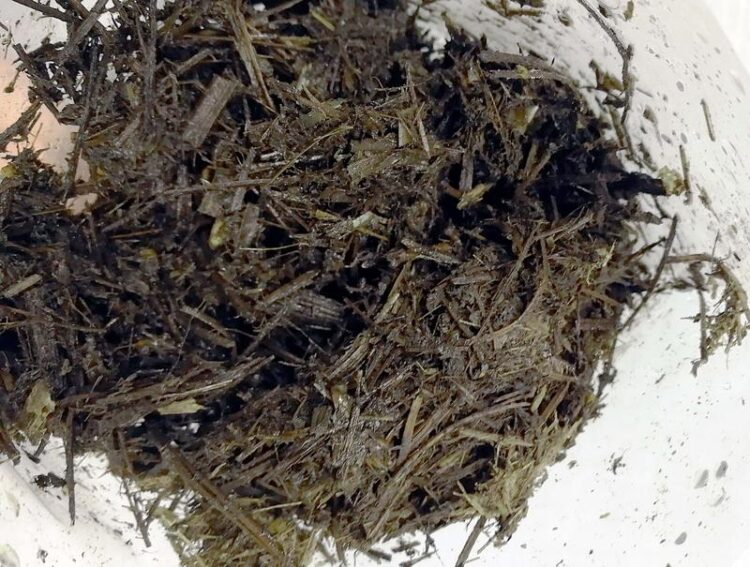Furniture from the biogas plant

Unwashed biogas digestate
(c) DITF
The Hallertau is Germany’s largest hop-growing region. During harvesting, hop bine chaff is left over, which is converted into environmentally friendly bio natural gas on site in a biogas plant. But that is not the end of the utilization chain for this fiber plant. Researchers at the German Institutes of Textile and Fiber Research Denkendorf (DITF) have used the plant-containing biogas digestate to produce a composite material that can be used to make furniture.
Laminates are in great demand in the furniture industry because they can be designed very flexibly. The composite material made from biogas digestate developed at the DITF with their project partners is a particularly sustainable variant. To produce it, these plant-based residues are first cleaned in an environmentally-friendly way. From this mass, the DITF and Reutlingen University have developed a wet laid nonwoven that is pressed together with a bio-based resin system to form a composite material. It is load-bearing and can be processed in a variety of ways. The project group has created an initial demonstrator from the material.
The project is an example of successful circular economy and value creation. Using biogas digestate as an industrial raw material is an environmentally-friendly alternative to their previous use as fertilizer, which increases nitrate pollution of the soil and is also significantly restricted by new regulations. Chemical additives are deliberately avoided in the production process, and if offcuts from the textile industry are also used in the design of the furniture, this results not only in unusual designs but also in further added value for the environment.
The research project was funded as part of the Central Innovation Program for SMEs (ZIM). The project partners were Hopfenpower GmbH, Novis GmbH and the joinery Nuding.
Wissenschaftliche Ansprechpartner:
Prof. Dr.-Ing. Markus Milwich
Deputy Head of Competence Center Polymers & Fiber Composites
Head of Fiber Composite Technology
T +49 (0)711 93 40-164
E markus.milwich@ditf.de
Media Contact
All latest news from the category: Ecology, The Environment and Conservation
This complex theme deals primarily with interactions between organisms and the environmental factors that impact them, but to a greater extent between individual inanimate environmental factors.
innovations-report offers informative reports and articles on topics such as climate protection, landscape conservation, ecological systems, wildlife and nature parks and ecosystem efficiency and balance.
Newest articles

High-energy-density aqueous battery based on halogen multi-electron transfer
Traditional non-aqueous lithium-ion batteries have a high energy density, but their safety is compromised due to the flammable organic electrolytes they utilize. Aqueous batteries use water as the solvent for…

First-ever combined heart pump and pig kidney transplant
…gives new hope to patient with terminal illness. Surgeons at NYU Langone Health performed the first-ever combined mechanical heart pump and gene-edited pig kidney transplant surgery in a 54-year-old woman…

Biophysics: Testing how well biomarkers work
LMU researchers have developed a method to determine how reliably target proteins can be labeled using super-resolution fluorescence microscopy. Modern microscopy techniques make it possible to examine the inner workings…





















